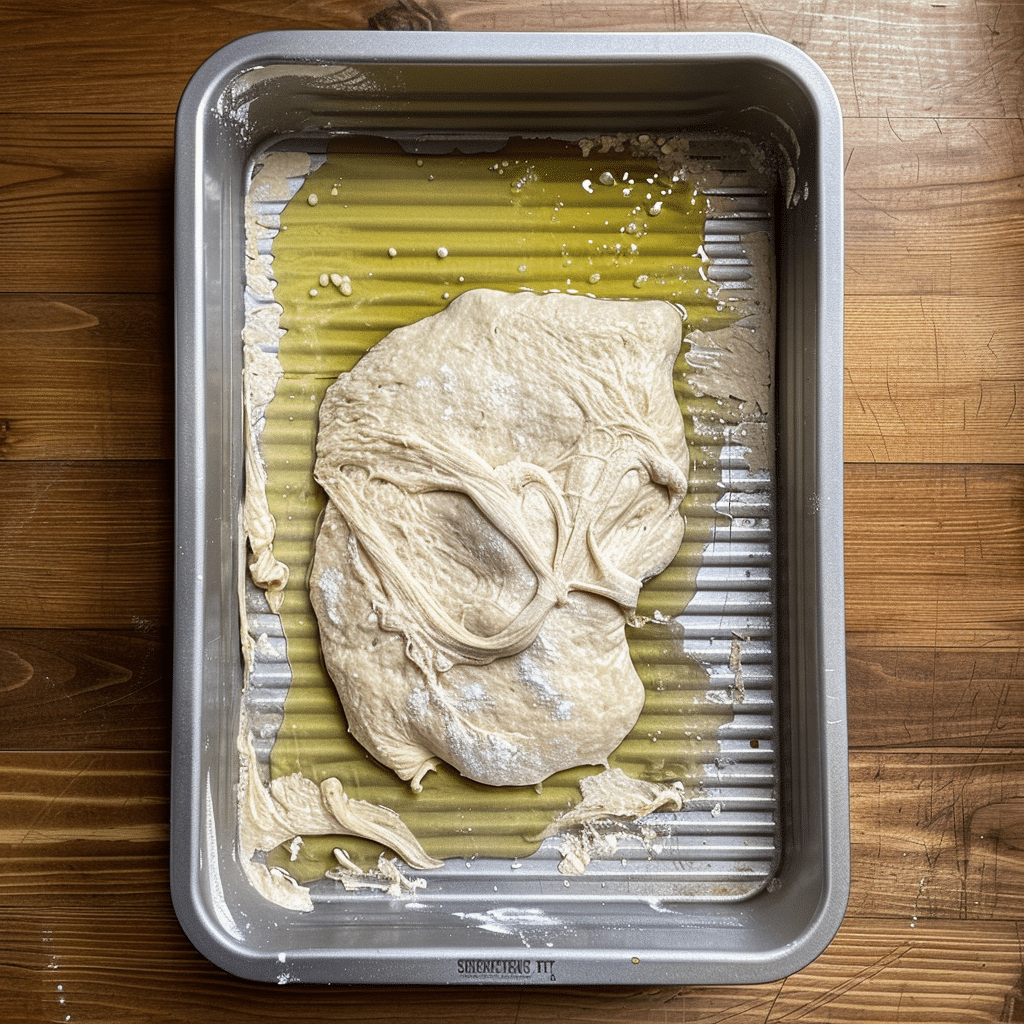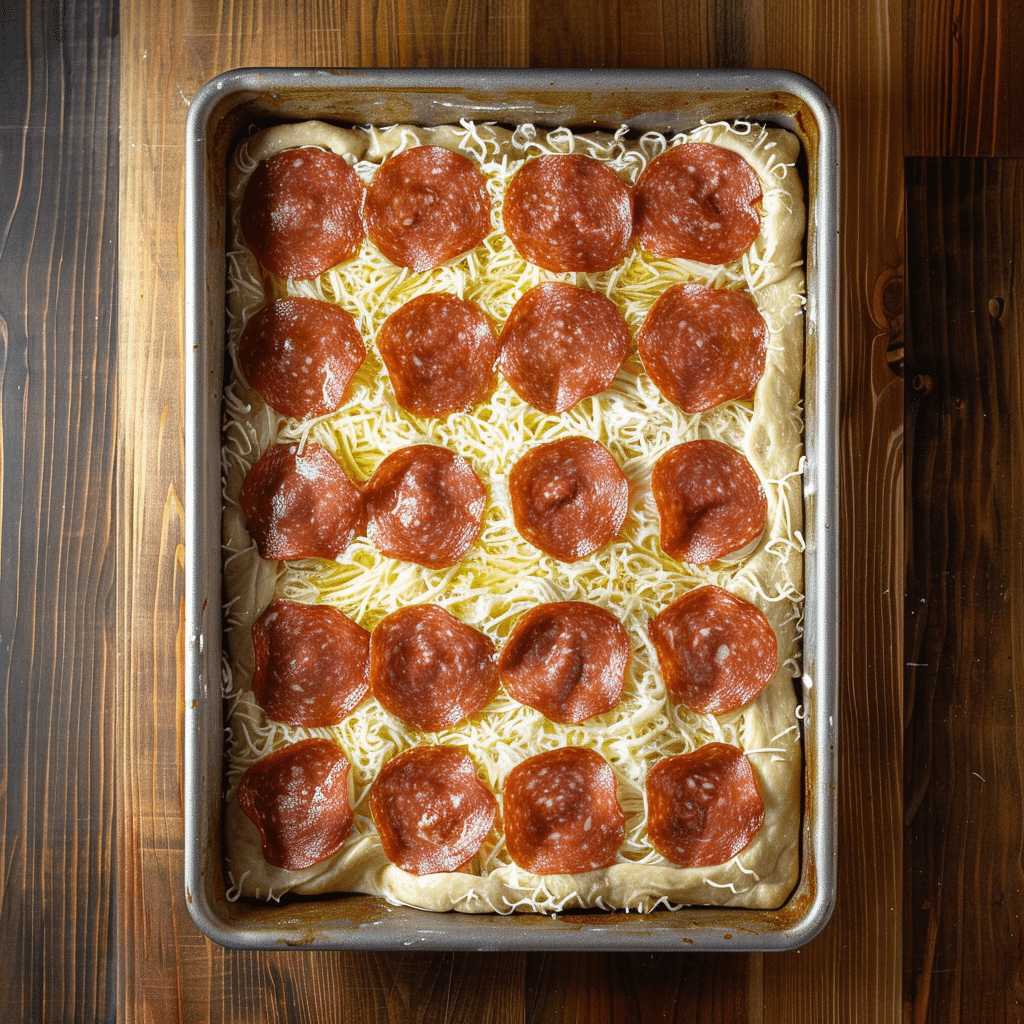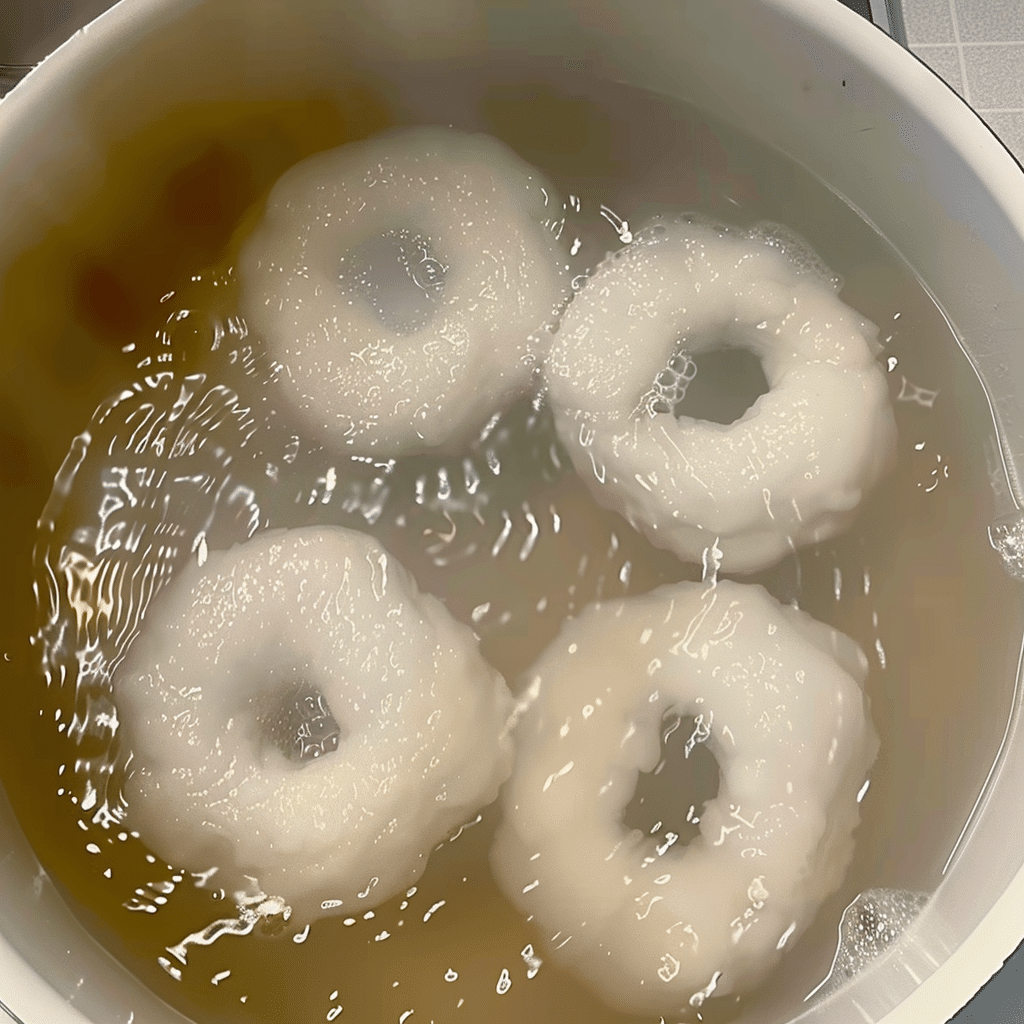Sometimes I think back to that one Friday night when my kids were cranky, my husband was late, and I had just enough energy to knead dough for pizza. But not just any pizza. That day, I tried making sourdough Detroit style pizza for the first time.
I remember pressing the bubbly dough into my old dark metal pan, the smell of sourdough mingling with mozzarella, and how everyone’s mood lifted when I pulled out a golden, cheesy, edge-to-edge masterpiece. It reminded me why I cook: not just to feed, but to create peace, love, and happy memories.
This sourdough Detroit style pizza recipe brings exactly that. It features a light, airy crust paired with gooey cheese and the signature caramelized edge that Detroit is known for. If you’ve never baked this style before, today’s the day to fill your kitchen with its comforting aroma.
Table of Contents
Bake the Best Sourdough Detroit Style Pizza at Home
- Total Time: 8 hours 55 minutes
- Yield: 6
Description
Detroit-style deep dish pizza at home with an easy sourdough crust that creates airy crumb, crispy edges, and gooey cheese in every slice.
Ingredients
350 grams water
100 grams active sourdough starter
10 grams olive oil + 3 tbsp for pan
500 grams all purpose or bread flour
15 grams salt
12 ounces shredded mozzarella
½ cup pizza sauce
Your favorite pizza toppings
Instructions
1. Combine water, starter, olive oil, flour, and salt in mixer bowl. Mix on low until combined.
2. Continue kneading for 5-7 minutes until dough looks smooth and stretchy.
3. Cover and rest 30 minutes.
4. Perform one round of stretch and folds, cover and rest 30 minutes.
5. Repeat a second round of stretch and folds, cover and rest 30 minutes.
6. Oil a 9×13 dark metal pan with 3 tbsp olive oil.
7. Transfer dough into pan, fold edges to form rectangle, lightly stretch.
8. Cover and rise 6-7 hours at room temperature until bubbly.
9. Press dough into corners with oiled fingers.
10. Top with half the cheese, pizza sauce, remaining cheese, and toppings.
11. Bake at 450°F on lowest rack for 25 minutes until crust is golden.
12. Run knife around edges immediately, remove to cutting board, cool briefly before slicing.
Notes
Use whole milk mozzarella for best melting and browning.
Cold ferment up to 24 hours for deeper flavor.
Serve hot for maximum cheesy stretch.
- Prep Time: 1 hour 30 minutes
- Cook Time: 25 minutes
- Category: Main
- Method: Bake
- Cuisine: American
Why Sourdough Makes Detroit Style Pizza Better
Using sourdough for authentic depth
Sourdough Detroit style pizza dough develops a deeper, slightly tangy flavor compared to commercial yeast dough. The natural fermentation also gives it better structure and digestibility.
When you mix 100 grams of active sourdough starter with water, flour, salt, and olive oil, the live cultures slowly expand the dough over 6–7 hours, creating that signature airy crumb with crisp edges.
- Benefits of sourdough crust:
- A zesty natural flavor that pairs well with creamy cheese and sauce.
- Stronger gluten development for fluffy interior
- Easier on digestion due to pre-fermentation
The best flour and hydration for Detroit style
Detroit style pizza needs high hydration to yield its signature open crumb. This sourdough Detroit style pizza uses 500 grams of all-purpose or bread flour with 350 grams of water, resulting in a slack dough that spreads easily in the pan.
Key tips:
- Bread flour will create more chew, while all-purpose keeps it soft.
- Always mix thoroughly for gluten formation, then perform stretch and folds to build strength despite its wet texture.
In the next part, I will cover shaping, rising, and troubleshooting your sourdough Detroit style pizza dough for a perfect bake every time.
Mastering the Rise: Shaping and Proofing for Perfect Texture
How to shape sourdough Detroit style pizza dough
One thing I learned from my first attempt at sourdough Detroit style pizza was not to panic about sticky dough. After mixing and kneading until it looks smooth and stretchy, let it rest for 30 minutes. Then do your first round of stretch and folds, pulling each side up and folding it over to build gluten strength. After another 30-minute rest, repeat a second round of stretch and folds. This helps your dough hold its shape and creates that airy interior without tearing.

Cold ferment for deeper flavor and flexibility
After shaping the dough in an oiled dark metal pan, you’ll notice it resists stretching fully into the corners. That’s fine. Cover it with plastic wrap and let it rise at room temperature for 6–7 hours until puffed with visible bubbles.
If your day gets busy, here’s the beauty: you can cover and refrigerate your sourdough Detroit style pizza dough for up to 24 hours after this rise. This cold ferment develops extra flavor complexity and fits perfectly into any schedule.
Table: Fast rise vs cold ferment benefits
| Rise Method | Benefits |
|---|---|
| Same day rise (room temp) | Ready in 6-7 hours, great open crumb, mild sourdough taste |
| Cold ferment (fridge) | Deeper tangy flavor, flexible timing, enhanced digestibility |
Troubleshooting dough shape
If your sourdough pizza dough is not holding its shape, check these:
- Starter wasn’t fully active. Feed 4–6 hours before mixing.
- Under kneading. Mix at least 5–7 minutes for gluten structure.
- Dough too cold. Allow it to warm slightly if refrigerated before shaping.
In Part 3, we’ll cover assembling, baking, and secrets for that iconic cheesy caramelized crust to finish your pizza with confidence.
Assemble and Bake: Your Guide to Perfect Sourdough Detroit Style Pizza Edges
Assembling your sourdough Detroit-style pizza prior to baking
After your dough finishes rising in its oiled pan, it’s time to turn it into a full sourdough Detroit style pizza. Preheat your oven to 450 degrees. Apply a small amount of oil to your fingers, then softly stretch the dough to reach all corners. Don’t force it too hard if it resists; it will stretch more during baking.
Here’s how I layer mine for the best results:
- Scatter half your mozzarella over the dough, letting cheese touch every edge to create those crisp caramelized sides Detroit pizza is known for.
- Spoon your pizza sauce on top of the cheese in small amounts, then gently spread it across the surface.
- Add your chosen toppings. I love pepperoni that curls up at the edges and mushrooms that soak in the sauce.
- Complete the dish by adding the rest of the cheese to seal in moisture and enhance flavor.

Secrets for achieving a crunchy caramelized cheese border
One of the best parts of sourdough Detroit style pizza is the crispy cheese that forms where it meets the hot pan. To guarantee it every time:
- Use whole milk mozzarella for rich melting and browning.
- Make sure cheese fully touches the pan’s edges.
- Place the pan on your oven’s bottom rack for about 25 minutes. This ensures the bottom turns golden and crunchy while cheese bubbles on top.
If you prefer deeply browned toppings, move your pan under the broiler for 1–2 minutes at the end, watching closely so it doesn’t burn. Broiling gives a beautiful finish and intensifies flavors without overbaking the crust.
Why does my sourdough Detroit style pizza dough spread too much?
If your dough ends up overly flat or refuses to hold shape:
- Make sure your sourdough starter was bubbly and active before using.
- Avoid letting dough overproof. Once it’s airy with visible bubbles, it’s ready.
- Don’t skip stretch and folds. They develop gluten strength so the dough holds gas and rises properly.
How to remove and slice without sticking
Once your sourdough Detroit style pizza is perfectly baked, act quickly. Use a slender knife to gently separate the cheese from the sides of the pan.
Carefully slide the pizza onto a cutting board. If it stays too long in the hot pan, the cheese will harden and stick, making removal difficult.
Allow the pizza to rest for five minutes before slicing into neat rectangles. This short wait lets cheese firm slightly, so every piece holds together with its bubbly melted top, crispy edges, and soft chewy sourdough crumb.
Storing and Reheating Your Sourdough Detroit Style Pizza
Tips for storing leftover Detroit-style sourdough pizza
If you have leftover slices (though in my house, they disappear fast), store them in an airtight container in the fridge for up to three days. Make sure the pieces are fully cooled before storing to prevent condensation that makes crust soggy.
Best way to reheat without losing crispness
To reheat your sourdough Detroit style pizza:
- Place slices on a baking sheet.
- Warm in a preheated 375-degree oven for 8–10 minutes until cheese is melted and edges are crisp again.
Avoid microwaving unless necessary, as it softens the crust instead of keeping it crispy.

Conclusion
Every time I make sourdough Detroit style pizza, I’m reminded how food connects us back to peace, comfort, and joy. The tangy sourdough, the golden cheesy edges, and the fluffy crumb make each bite a moment of warmth. Whether you bake it on a busy Wednesday night or slow Sunday afternoon, this recipe brings bakery-quality pizza to your table with love and ease.
Sourdough Detroit Style Pizza FAQs: Dough, Rising, and Baking Tips
What is the best dough for Detroit pizza?
The best dough is a high-hydration dough, ideally using bread flour for structure and chew. A sourdough-based dough brings natural tang, strong gluten, and digestibility, giving Detroit pizza its rich flavor and light airy crumb.
Why is my sourdough pizza dough not holding its shape?
Your dough may spread too much if:
Your starter wasn’t fully active before mixing.
Stretch and folds were skipped, leading to weak gluten development.
Dough was over-proofed, losing its gas structure.
Do you have to refrigerate sourdough pizza dough?
No, but refrigerating after the first rise deepens flavor and adds flexibility to your baking schedule. Cold fermenting up to 24 hours enhances tang and gluten strength while fitting around busy days.
If you’re looking for a faster option, check out my same day sourdough pizza crust recipe for quick pizza nights.
For a thinner option, check out my No Yeast Sourdough Discard Pizza Dough, perfect for quick same-day pizza nights.
For more recipes follow me on : pinterest and medium
Warning: This article is provided for strictly informative purposes and cannot be replaced in any case as a medical professional, a diagnosis or a treatment.
For all health questions, you should consult a qualified health professional.










1 thought on “Bake the Best Sourdough Detroit Style Pizza at Home”